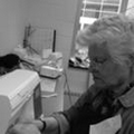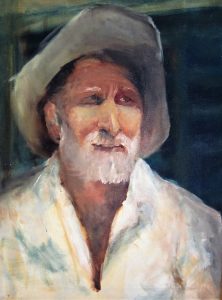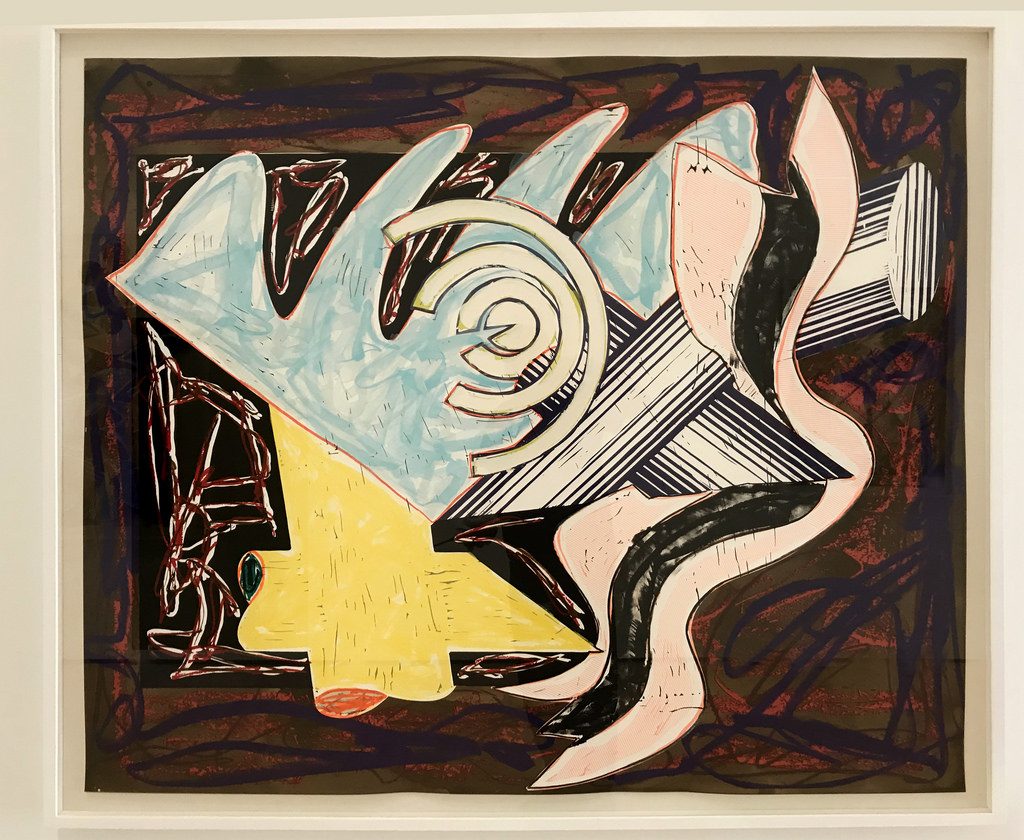Written by Marla Ogden
Story edited and packaged by Jessie Russell
Students in Professor Lindsay Lennon’s Feature Writing class were assigned interviews with SUNY New Paltz alumni who were featured in Wired Gallery’s “Golden Age of New Paltz” exhibition. This is what they found:
Featured images by Jack Murphy and SUNY Ulster
Aletta Vett is an accomplished costume designer who has defied rules and created her own life, borne out of the experiences she had at New Paltz. Her passion led her to work on documentaries and teaching future artists.
Aletta Vett was raised in Huntington Station, New York. She enjoys sculpting, drawing and painting, but now is a professional costume designer. It was her passion for art that led her to New Paltz in the 1960s. It wasn’t long after her arrival that she met her husband of 57 years, John Vett, who was a musician. The two instantly fell madly in love. They have two children, now men with children of their own. In fact, one of their sons is named Ilya, after Vett’s beloved SUNY New Paltz art professor, Ilya Bolotowsky. Together, they lived through and experienced the time known as “the Golden Age of New Paltz” during the 1960s.
What brought you to SUNY New Paltz?
I came to New Paltz in 1959. SUNY New Paltz was one of the few state schools that had an art program. The faculty was young and enthusiastic. They were talented, and they taught to supplement their art endeavors, which is what most artists do. My drawing teacher, Mr. Bolotowsky, had retrospective events at the Guggenheim. When we came together it was like magic. Each [student] in their own right went on to become a professional artist. They made their living as artists, and that’s pretty amazing when you think about it.
What was it like at SUNY New Paltz at the time?
The art community itself was extremely tiny. Within the school community, the art students were considered to be “hippies.” We would run around with paint splattered clothes. We were like our own fraternity or sorority, and we would hang and do artwork together. When you have a group like we had, one person would spark the other ones. There was an incredible exchange of information, talent and technique. We had startling discussions about politics and the world in general, but mostly about art. It was very special and, for me, exciting. Because our group within the school was so small, we all knew each other, and believe it or not, 50 to 60 years later, we’re all still friends.

How was it different for you as a female college student?
When I was going to school it was a very different time for women. Young women could aspire to be a legal secretary, teacher or nurse. If you went to your guidance counselor and asked to be an archeologist, the answer was, “Women don’t do that.” As a freshman, I had a curfew. If you disregarded the rules you’d be “campused,” which meant you had to be in by 7:30 p.m. every night. The boys, on the other hand, didn’t have curfews. There was also a dress code on campus for dinner. As a woman, you had to wear a skirt while boys could wear pants. I would rail against the rules—I was campused a lot.
Was your family supportive of your area of study?
Simply? No. My home life as a child growing up was anything but idyllic.
What made you transition to costume design?
My work has gone to a different place. I design and build costumes for theatre. It’s a very strange job, but that’s what I do. From the time I was a very small kid, I would make elaborate costumes and include all of my siblings. I’ve always been fascinated by the history of dress. I took an elective class at SUNY New Paltz called summer theatre. I knew how to sew, so one day I went to the costume shop because they were having trouble, and I never left. It was like this Pandora’s Box that just opened up. I began to volunteer when they were doing shows. After I graduated from school I was asked by the local theatre community, 90 Miles off of Broadway, to help out. Eventually, I became a shop manager after I retired from my regular teaching job.
What did you teach?
I was an art teacher, for the most part. I taught everything from elementary to high school. I loved to teach. I also worked for the Department of Corrections at a maximum security prison, Greenhaven, where I taught art for 15 years. I worked at SUNY New Paltz for 10 years in the costume shop and taught classes. As of now, I’ve worked for SUNY Ulster for 11 years. I also work at Shadowland [in Ellenville, New York]. There, the actors are professional. It’s a very interesting place to work because it’s one of the few professional theatres in the Hudson Valley. But of all of the jobs that I have done in my life, the best job is being a grandma.
How many shows do you think you’ve done?
I don’t even know how to measure that. I’ve done hundreds of shows, and have done each one multiple times.
 What does the Golden Age of New Paltz mean to you?
What does the Golden Age of New Paltz mean to you?
It was a time when we as artists explored our own art because we didn’t have any boundaries. There were no conventions, rules or regulations. The school was just starting and the stars were aligned. It was about how we all came together and were able to connect. It was an unbelievable time. It had to do with our faculty; they supported us. Still, when we have a show and the professors come in, it’s like we’re back in their classes. It’s a special feeling that was formed when we were very young and just starting out and it has continued. It was a golden age because it was a time of great exploration. I valued their friendship then, and I value their friendship now. The artwork was exciting, and it still is. Us old farts are still doing it!
Read about other #GoldenAge artists here:
Jack Murphy offers a snapshot of what it was like to be an artist in New Paltz during the “Golden Age,” and his inspiration behind curating the exhibition.
Fern T. Apfel is a text-based illustrative artist who constructs collages using various mediums. An alumna of SUNY New Paltz, Apfel reflects on her growth, inspirations and favorite artists.
Jo-Ellen Trilling is an artist from the era of protest art in 1968 to 1971 who intertwines magical realism with art to reflect life within the political climate at the time.
Bruce Pileggi is an alumnus of SUNY New Paltz who delves into his past and explores themes that motivated him to pursue a career in art.
Jerry Vis is an architectural designer who, at 79 years old, still remains creatively curious when it comes to making art.
Ed Samuels began drawing early in his childhood after being influenced by his family of artists. He found his niche during the ‘60s and ‘70s after seeing the beauty in all environments, from New York City streets to Sante Fe’s cliffs and beaches.
Jon Ellis Stevens is an award-winning photographer and New Paltz alumnus. He discusses his desire to show that photography is more than capturing still images and how the radical times of the ‘60s inspires his artwork.
Sevan Melikyan is a native from Turkey who journeyed with the dream of becoming an artist to America, where he became enthralled with the rich artistic history of New Paltz.
Eileen Cowin is a multi-medium artist from New York who creates politically charged work inspired by the 1970s and today and connects them in abstract ways.
Shelley Davis is a woman of many art forms, including a style she created herself as a graduate student. Her groundbreaking “photo fusion” art has travelled the globe, featured in galleries across Europe and the United States.
Robert Crimi is an artist from the Bronx who is inspired by jazz music and creates colorful oil paintings with techniques his muralist uncle taught him.
Rosalie Rossi, an alumna of SUNY New Paltz, has taught art to students from preschool to the college level. She believes every student she teaches should do a self portrait.
Michael Velkovich, an alumnus of SUNY New Paltz, uses printmaking to express his artistic vision. He reflects on his journey as an artist, how he faced critics and how he has given back to the arts community.
Win Bottum-Morgan took a drawing class hoping to learn the mechanics of art but was instead taught how to see the world in a different light. This perspective ignited his passion for painting. He continues to pursue art while practicing as a clinical psychologist in Corte Madera, California.
Larry Audette, not only an artist but a Jazz musician, talks about his memorable time at New Paltz with an array of artists who felt like family to him.
Rosalind “Roz” Zarr creates wearable art. Her jewelry is the only of its medium featured in the “Golden Age of New Paltz,” a testament of her prolific experience at the university in the late ’60s.
